University Economics for Managers: Financial Crisis Analysis Report
VerifiedAdded on 2022/10/19
|13
|2542
|284
Report
AI Summary
This report, prepared for an Economics for Managers course, examines the causes of the global financial crisis of 2006-2009. It investigates the debate surrounding whether the crisis was primarily caused by financial innovations aimed at creating safe debt instruments or the collapse of the housing bubble. The report analyzes the impact of debt contracts, applying the Coase theorem to mitigate negative externalities, and discusses the role of shared responsibility mortgages in mitigating risks. It explores the effects of securitization on the mortgage market, the impact of macroeconomic environments, and the role of government policies, such as interest rate adjustments and the distribution of stimulus checks. The analysis also covers the role of global imbalances, including the United States' account deficits and the development of safe assets, as well as the securitization of lower-quality assets. The report concludes with recommendations for future macroeconomic policies, emphasizing the importance of maintaining equilibrium interest rates to avoid distortions in the demand for financial products. The report references various academic sources to support its findings.
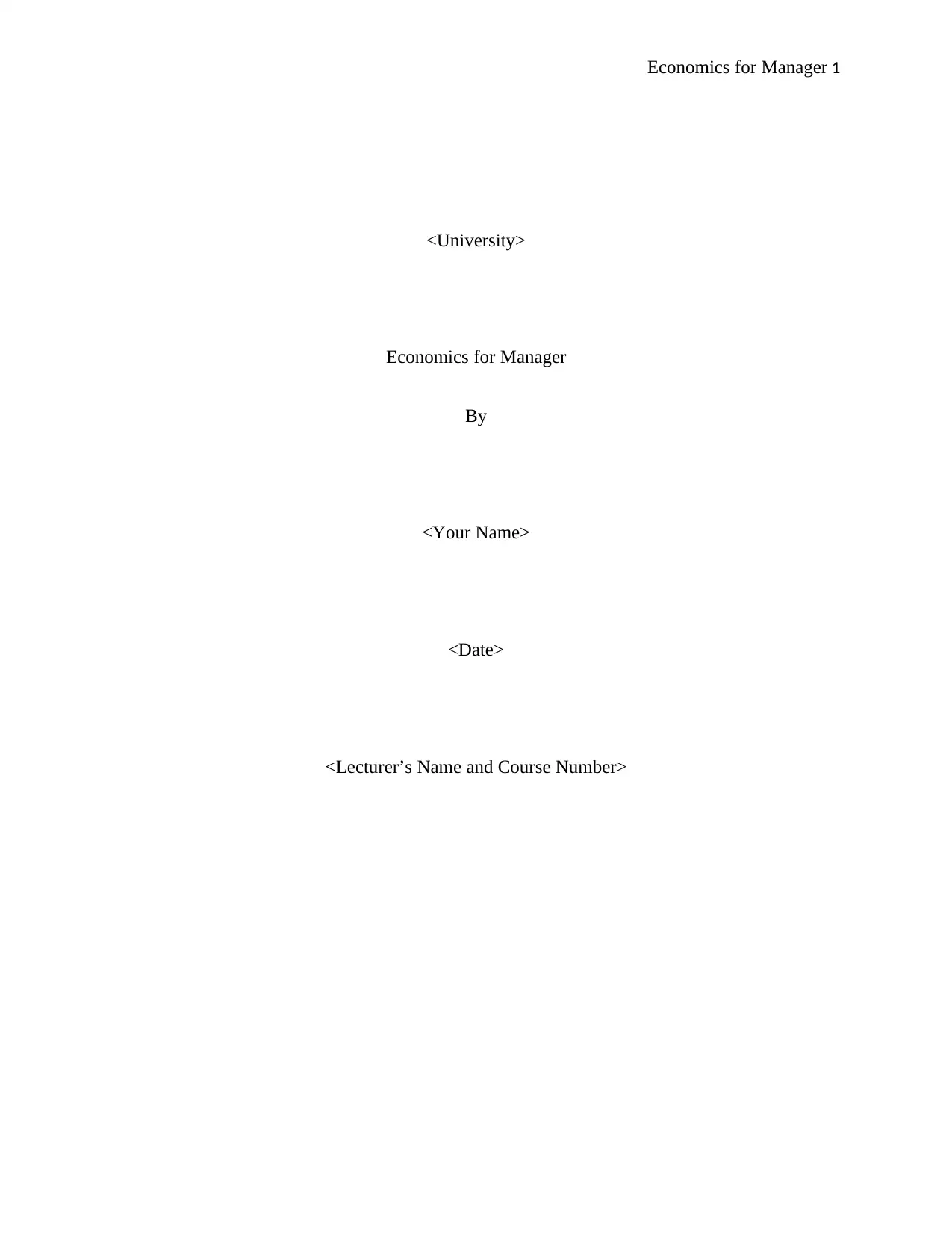
Economics for Manager 1
<University>
Economics for Manager
By
<Your Name>
<Date>
<Lecturer’s Name and Course Number>
<University>
Economics for Manager
By
<Your Name>
<Date>
<Lecturer’s Name and Course Number>
Paraphrase This Document
Need a fresh take? Get an instant paraphrase of this document with our AI Paraphraser

Economics for Manager 2
Executive Summary
Financial crisis greatly impacted the global economy in the period between 2006 and 2009 as
financial systems were negatively impacted by the eventual fall in demand for financial products
and services. The financial crisis mainly occurred due to financial innovations by developed
economies to create more safe debt instruments without prior consideration of global imbalances.
As such, policies that were formulated to address the global imbalances exposed the economies
to the eventual financial crisis. Reversing of capital inflows as a macroeconomic policy,
securitization of low quality assets and creation of more safe assets were some of the policies
that greatly contributed to occurrence of the global financial crisis.
Executive Summary
Financial crisis greatly impacted the global economy in the period between 2006 and 2009 as
financial systems were negatively impacted by the eventual fall in demand for financial products
and services. The financial crisis mainly occurred due to financial innovations by developed
economies to create more safe debt instruments without prior consideration of global imbalances.
As such, policies that were formulated to address the global imbalances exposed the economies
to the eventual financial crisis. Reversing of capital inflows as a macroeconomic policy,
securitization of low quality assets and creation of more safe assets were some of the policies
that greatly contributed to occurrence of the global financial crisis.
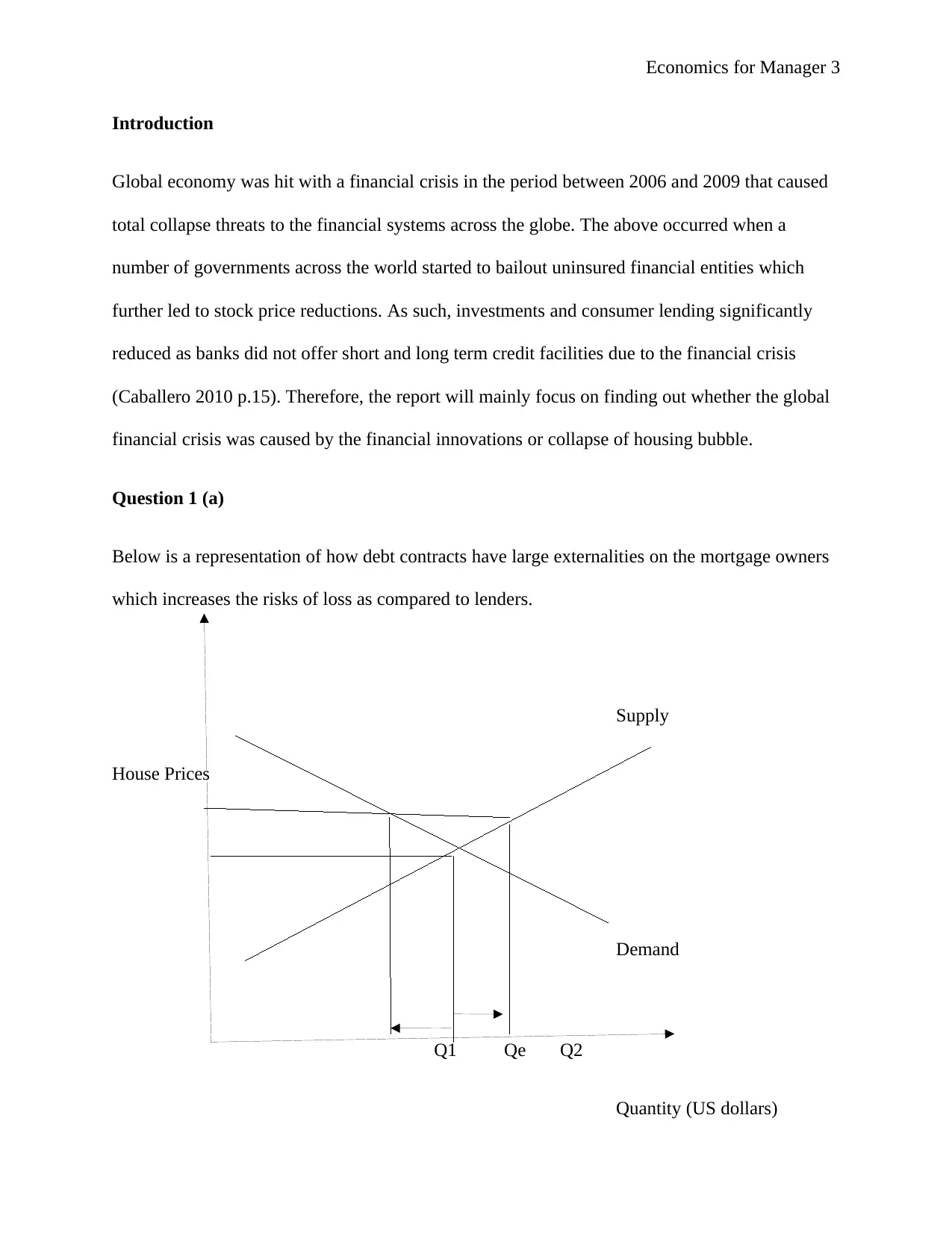
Economics for Manager 3
Introduction
Global economy was hit with a financial crisis in the period between 2006 and 2009 that caused
total collapse threats to the financial systems across the globe. The above occurred when a
number of governments across the world started to bailout uninsured financial entities which
further led to stock price reductions. As such, investments and consumer lending significantly
reduced as banks did not offer short and long term credit facilities due to the financial crisis
(Caballero 2010 p.15). Therefore, the report will mainly focus on finding out whether the global
financial crisis was caused by the financial innovations or collapse of housing bubble.
Question 1 (a)
Below is a representation of how debt contracts have large externalities on the mortgage owners
which increases the risks of loss as compared to lenders.
Supply
House Prices
Demand
Q1 Qe Q2
Quantity (US dollars)
Introduction
Global economy was hit with a financial crisis in the period between 2006 and 2009 that caused
total collapse threats to the financial systems across the globe. The above occurred when a
number of governments across the world started to bailout uninsured financial entities which
further led to stock price reductions. As such, investments and consumer lending significantly
reduced as banks did not offer short and long term credit facilities due to the financial crisis
(Caballero 2010 p.15). Therefore, the report will mainly focus on finding out whether the global
financial crisis was caused by the financial innovations or collapse of housing bubble.
Question 1 (a)
Below is a representation of how debt contracts have large externalities on the mortgage owners
which increases the risks of loss as compared to lenders.
Supply
House Prices
Demand
Q1 Qe Q2
Quantity (US dollars)
⊘ This is a preview!⊘
Do you want full access?
Subscribe today to unlock all pages.

Trusted by 1+ million students worldwide
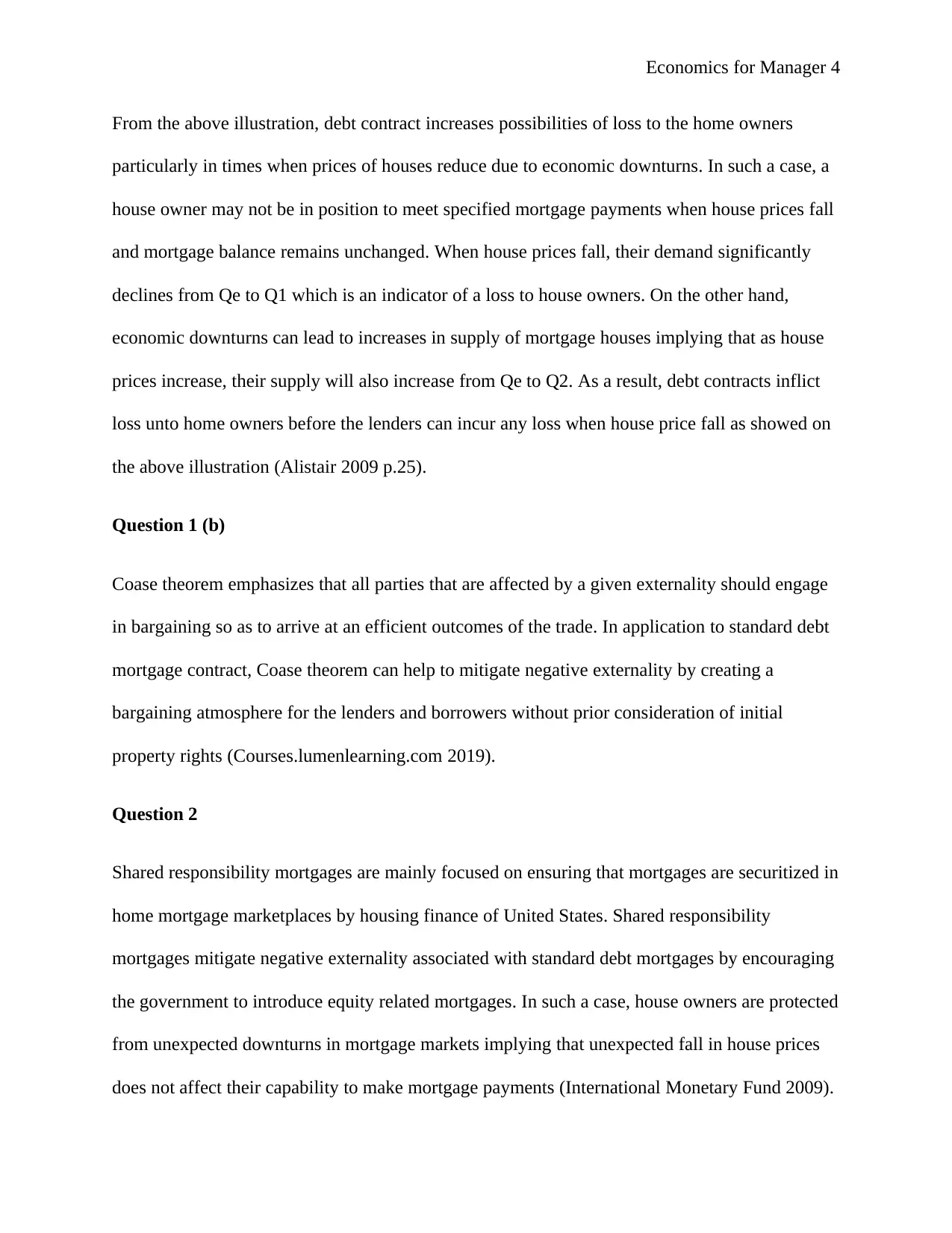
Economics for Manager 4
From the above illustration, debt contract increases possibilities of loss to the home owners
particularly in times when prices of houses reduce due to economic downturns. In such a case, a
house owner may not be in position to meet specified mortgage payments when house prices fall
and mortgage balance remains unchanged. When house prices fall, their demand significantly
declines from Qe to Q1 which is an indicator of a loss to house owners. On the other hand,
economic downturns can lead to increases in supply of mortgage houses implying that as house
prices increase, their supply will also increase from Qe to Q2. As a result, debt contracts inflict
loss unto home owners before the lenders can incur any loss when house price fall as showed on
the above illustration (Alistair 2009 p.25).
Question 1 (b)
Coase theorem emphasizes that all parties that are affected by a given externality should engage
in bargaining so as to arrive at an efficient outcomes of the trade. In application to standard debt
mortgage contract, Coase theorem can help to mitigate negative externality by creating a
bargaining atmosphere for the lenders and borrowers without prior consideration of initial
property rights (Courses.lumenlearning.com 2019).
Question 2
Shared responsibility mortgages are mainly focused on ensuring that mortgages are securitized in
home mortgage marketplaces by housing finance of United States. Shared responsibility
mortgages mitigate negative externality associated with standard debt mortgages by encouraging
the government to introduce equity related mortgages. In such a case, house owners are protected
from unexpected downturns in mortgage markets implying that unexpected fall in house prices
does not affect their capability to make mortgage payments (International Monetary Fund 2009).
From the above illustration, debt contract increases possibilities of loss to the home owners
particularly in times when prices of houses reduce due to economic downturns. In such a case, a
house owner may not be in position to meet specified mortgage payments when house prices fall
and mortgage balance remains unchanged. When house prices fall, their demand significantly
declines from Qe to Q1 which is an indicator of a loss to house owners. On the other hand,
economic downturns can lead to increases in supply of mortgage houses implying that as house
prices increase, their supply will also increase from Qe to Q2. As a result, debt contracts inflict
loss unto home owners before the lenders can incur any loss when house price fall as showed on
the above illustration (Alistair 2009 p.25).
Question 1 (b)
Coase theorem emphasizes that all parties that are affected by a given externality should engage
in bargaining so as to arrive at an efficient outcomes of the trade. In application to standard debt
mortgage contract, Coase theorem can help to mitigate negative externality by creating a
bargaining atmosphere for the lenders and borrowers without prior consideration of initial
property rights (Courses.lumenlearning.com 2019).
Question 2
Shared responsibility mortgages are mainly focused on ensuring that mortgages are securitized in
home mortgage marketplaces by housing finance of United States. Shared responsibility
mortgages mitigate negative externality associated with standard debt mortgages by encouraging
the government to introduce equity related mortgages. In such a case, house owners are protected
from unexpected downturns in mortgage markets implying that unexpected fall in house prices
does not affect their capability to make mortgage payments (International Monetary Fund 2009).
Paraphrase This Document
Need a fresh take? Get an instant paraphrase of this document with our AI Paraphraser
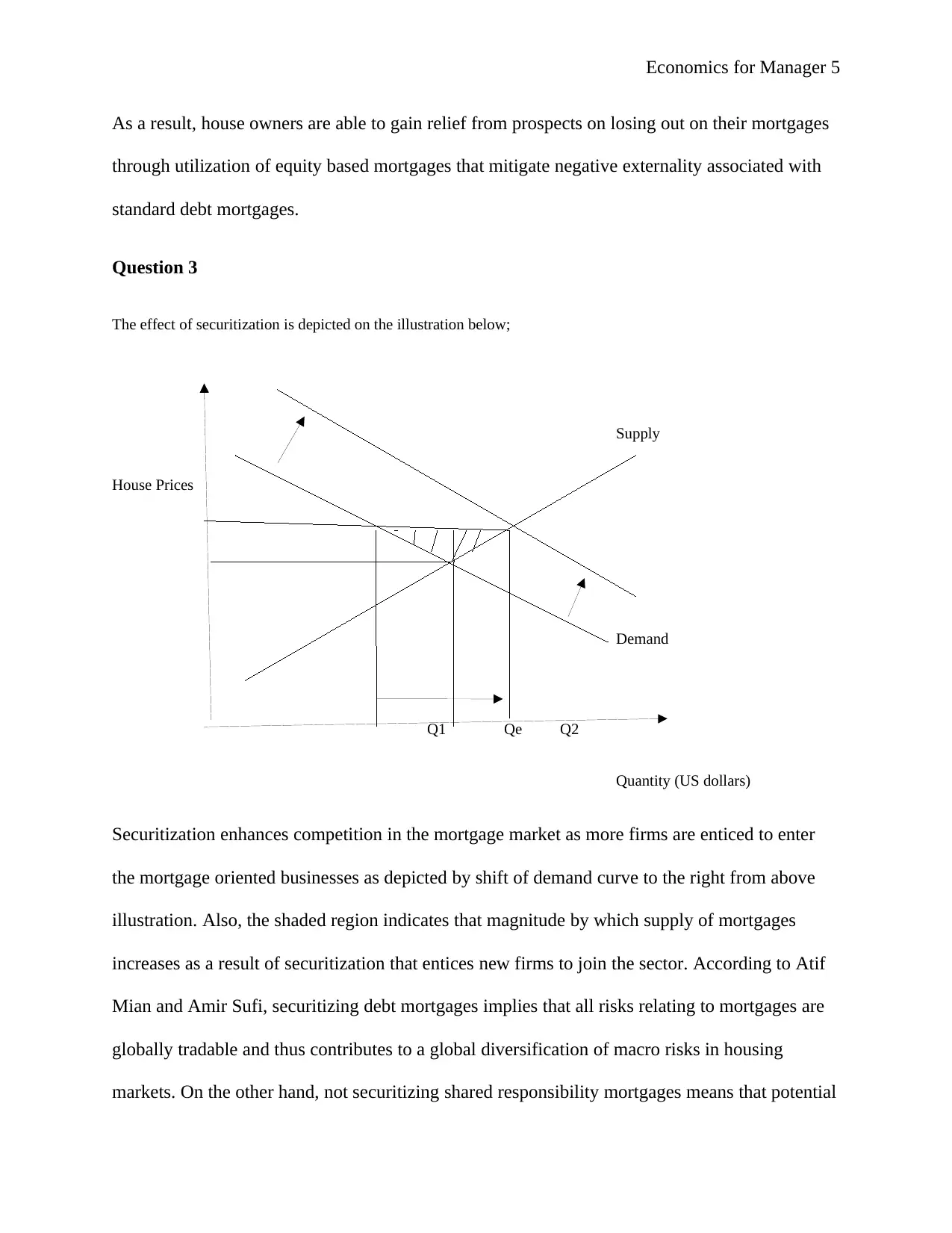
Economics for Manager 5
As a result, house owners are able to gain relief from prospects on losing out on their mortgages
through utilization of equity based mortgages that mitigate negative externality associated with
standard debt mortgages.
Question 3
The effect of securitization is depicted on the illustration below;
Supply
House Prices
Demand
Q1 Qe Q2
Quantity (US dollars)
Securitization enhances competition in the mortgage market as more firms are enticed to enter
the mortgage oriented businesses as depicted by shift of demand curve to the right from above
illustration. Also, the shaded region indicates that magnitude by which supply of mortgages
increases as a result of securitization that entices new firms to join the sector. According to Atif
Mian and Amir Sufi, securitizing debt mortgages implies that all risks relating to mortgages are
globally tradable and thus contributes to a global diversification of macro risks in housing
markets. On the other hand, not securitizing shared responsibility mortgages means that potential
As a result, house owners are able to gain relief from prospects on losing out on their mortgages
through utilization of equity based mortgages that mitigate negative externality associated with
standard debt mortgages.
Question 3
The effect of securitization is depicted on the illustration below;
Supply
House Prices
Demand
Q1 Qe Q2
Quantity (US dollars)
Securitization enhances competition in the mortgage market as more firms are enticed to enter
the mortgage oriented businesses as depicted by shift of demand curve to the right from above
illustration. Also, the shaded region indicates that magnitude by which supply of mortgages
increases as a result of securitization that entices new firms to join the sector. According to Atif
Mian and Amir Sufi, securitizing debt mortgages implies that all risks relating to mortgages are
globally tradable and thus contributes to a global diversification of macro risks in housing
markets. On the other hand, not securitizing shared responsibility mortgages means that potential
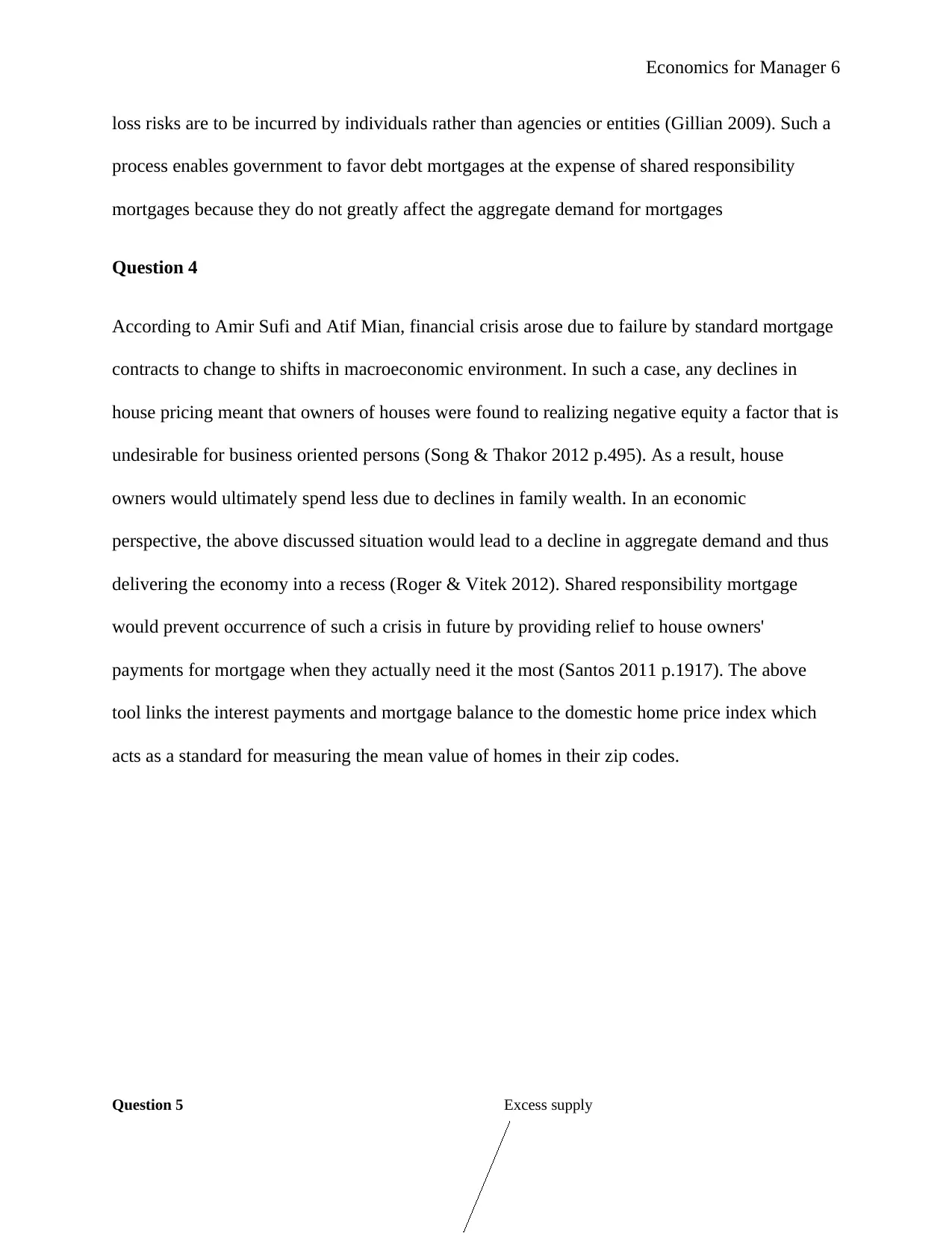
Economics for Manager 6
loss risks are to be incurred by individuals rather than agencies or entities (Gillian 2009). Such a
process enables government to favor debt mortgages at the expense of shared responsibility
mortgages because they do not greatly affect the aggregate demand for mortgages
Question 4
According to Amir Sufi and Atif Mian, financial crisis arose due to failure by standard mortgage
contracts to change to shifts in macroeconomic environment. In such a case, any declines in
house pricing meant that owners of houses were found to realizing negative equity a factor that is
undesirable for business oriented persons (Song & Thakor 2012 p.495). As a result, house
owners would ultimately spend less due to declines in family wealth. In an economic
perspective, the above discussed situation would lead to a decline in aggregate demand and thus
delivering the economy into a recess (Roger & Vitek 2012). Shared responsibility mortgage
would prevent occurrence of such a crisis in future by providing relief to house owners'
payments for mortgage when they actually need it the most (Santos 2011 p.1917). The above
tool links the interest payments and mortgage balance to the domestic home price index which
acts as a standard for measuring the mean value of homes in their zip codes.
Question 5 Excess supply
loss risks are to be incurred by individuals rather than agencies or entities (Gillian 2009). Such a
process enables government to favor debt mortgages at the expense of shared responsibility
mortgages because they do not greatly affect the aggregate demand for mortgages
Question 4
According to Amir Sufi and Atif Mian, financial crisis arose due to failure by standard mortgage
contracts to change to shifts in macroeconomic environment. In such a case, any declines in
house pricing meant that owners of houses were found to realizing negative equity a factor that is
undesirable for business oriented persons (Song & Thakor 2012 p.495). As a result, house
owners would ultimately spend less due to declines in family wealth. In an economic
perspective, the above discussed situation would lead to a decline in aggregate demand and thus
delivering the economy into a recess (Roger & Vitek 2012). Shared responsibility mortgage
would prevent occurrence of such a crisis in future by providing relief to house owners'
payments for mortgage when they actually need it the most (Santos 2011 p.1917). The above
tool links the interest payments and mortgage balance to the domestic home price index which
acts as a standard for measuring the mean value of homes in their zip codes.
Question 5 Excess supply
⊘ This is a preview!⊘
Do you want full access?
Subscribe today to unlock all pages.

Trusted by 1+ million students worldwide
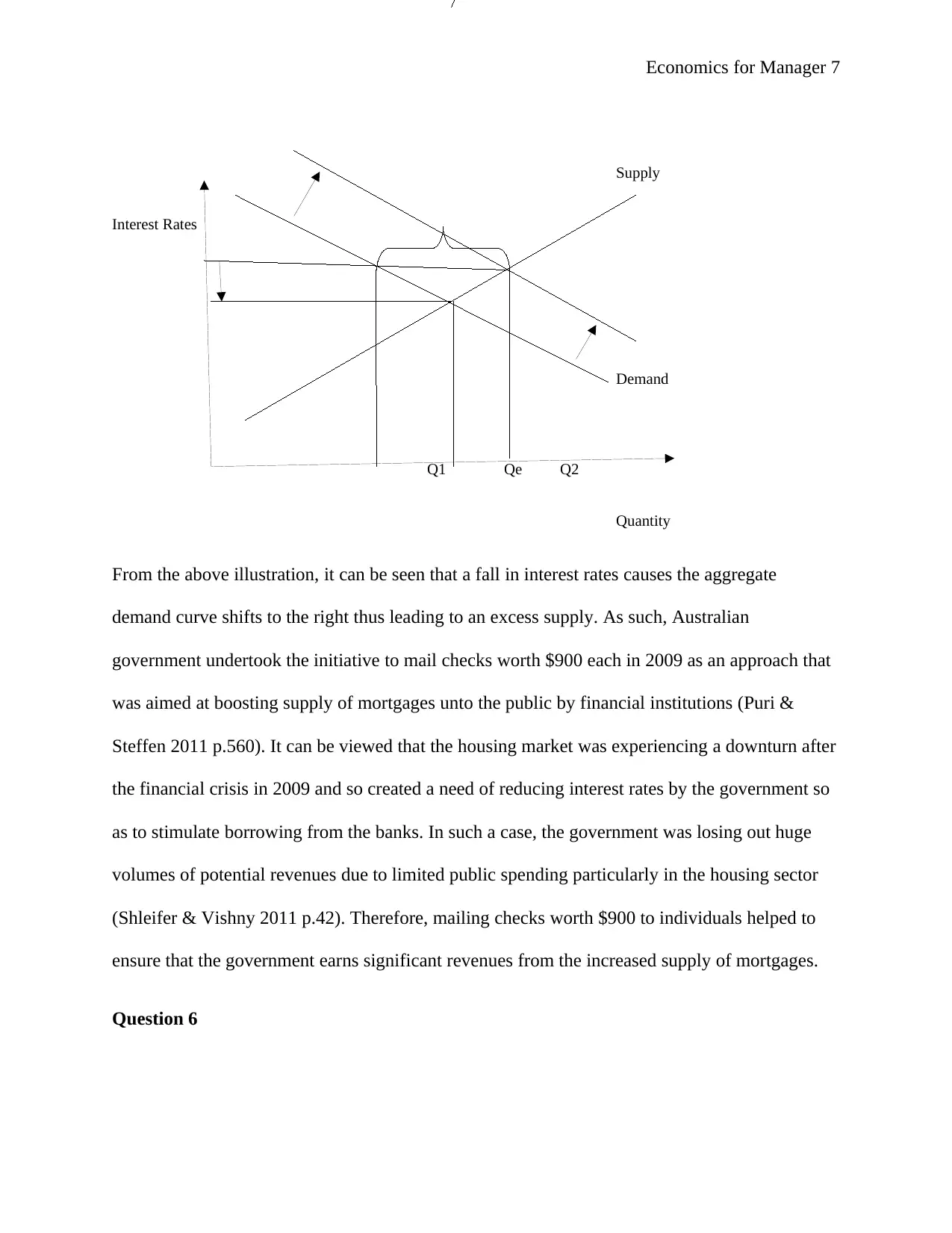
Economics for Manager 7
Supply
Interest Rates
Demand
Q1 Qe Q2
Quantity
From the above illustration, it can be seen that a fall in interest rates causes the aggregate
demand curve shifts to the right thus leading to an excess supply. As such, Australian
government undertook the initiative to mail checks worth $900 each in 2009 as an approach that
was aimed at boosting supply of mortgages unto the public by financial institutions (Puri &
Steffen 2011 p.560). It can be viewed that the housing market was experiencing a downturn after
the financial crisis in 2009 and so created a need of reducing interest rates by the government so
as to stimulate borrowing from the banks. In such a case, the government was losing out huge
volumes of potential revenues due to limited public spending particularly in the housing sector
(Shleifer & Vishny 2011 p.42). Therefore, mailing checks worth $900 to individuals helped to
ensure that the government earns significant revenues from the increased supply of mortgages.
Question 6
Supply
Interest Rates
Demand
Q1 Qe Q2
Quantity
From the above illustration, it can be seen that a fall in interest rates causes the aggregate
demand curve shifts to the right thus leading to an excess supply. As such, Australian
government undertook the initiative to mail checks worth $900 each in 2009 as an approach that
was aimed at boosting supply of mortgages unto the public by financial institutions (Puri &
Steffen 2011 p.560). It can be viewed that the housing market was experiencing a downturn after
the financial crisis in 2009 and so created a need of reducing interest rates by the government so
as to stimulate borrowing from the banks. In such a case, the government was losing out huge
volumes of potential revenues due to limited public spending particularly in the housing sector
(Shleifer & Vishny 2011 p.42). Therefore, mailing checks worth $900 to individuals helped to
ensure that the government earns significant revenues from the increased supply of mortgages.
Question 6
Paraphrase This Document
Need a fresh take? Get an instant paraphrase of this document with our AI Paraphraser
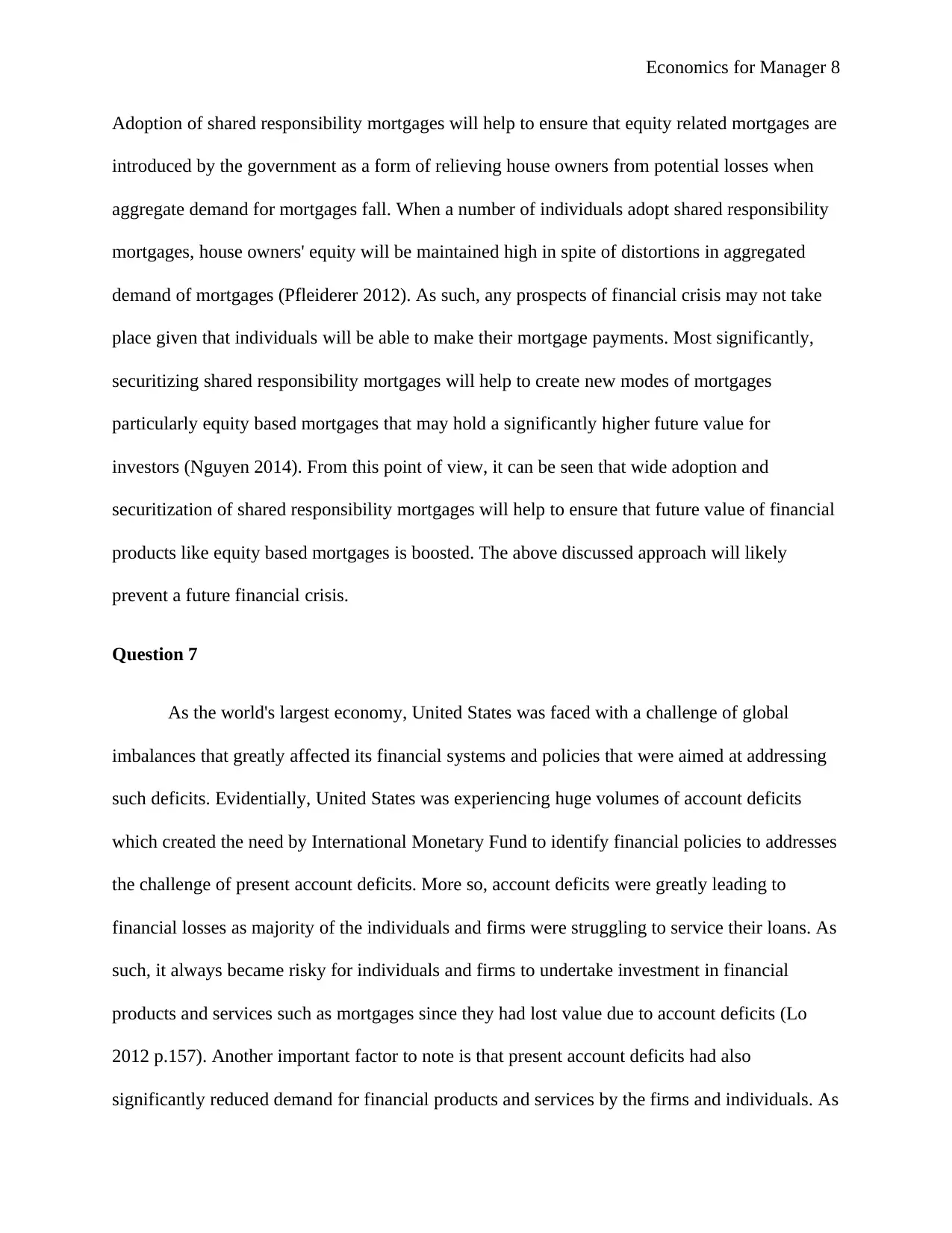
Economics for Manager 8
Adoption of shared responsibility mortgages will help to ensure that equity related mortgages are
introduced by the government as a form of relieving house owners from potential losses when
aggregate demand for mortgages fall. When a number of individuals adopt shared responsibility
mortgages, house owners' equity will be maintained high in spite of distortions in aggregated
demand of mortgages (Pfleiderer 2012). As such, any prospects of financial crisis may not take
place given that individuals will be able to make their mortgage payments. Most significantly,
securitizing shared responsibility mortgages will help to create new modes of mortgages
particularly equity based mortgages that may hold a significantly higher future value for
investors (Nguyen 2014). From this point of view, it can be seen that wide adoption and
securitization of shared responsibility mortgages will help to ensure that future value of financial
products like equity based mortgages is boosted. The above discussed approach will likely
prevent a future financial crisis.
Question 7
As the world's largest economy, United States was faced with a challenge of global
imbalances that greatly affected its financial systems and policies that were aimed at addressing
such deficits. Evidentially, United States was experiencing huge volumes of account deficits
which created the need by International Monetary Fund to identify financial policies to addresses
the challenge of present account deficits. More so, account deficits were greatly leading to
financial losses as majority of the individuals and firms were struggling to service their loans. As
such, it always became risky for individuals and firms to undertake investment in financial
products and services such as mortgages since they had lost value due to account deficits (Lo
2012 p.157). Another important factor to note is that present account deficits had also
significantly reduced demand for financial products and services by the firms and individuals. As
Adoption of shared responsibility mortgages will help to ensure that equity related mortgages are
introduced by the government as a form of relieving house owners from potential losses when
aggregate demand for mortgages fall. When a number of individuals adopt shared responsibility
mortgages, house owners' equity will be maintained high in spite of distortions in aggregated
demand of mortgages (Pfleiderer 2012). As such, any prospects of financial crisis may not take
place given that individuals will be able to make their mortgage payments. Most significantly,
securitizing shared responsibility mortgages will help to create new modes of mortgages
particularly equity based mortgages that may hold a significantly higher future value for
investors (Nguyen 2014). From this point of view, it can be seen that wide adoption and
securitization of shared responsibility mortgages will help to ensure that future value of financial
products like equity based mortgages is boosted. The above discussed approach will likely
prevent a future financial crisis.
Question 7
As the world's largest economy, United States was faced with a challenge of global
imbalances that greatly affected its financial systems and policies that were aimed at addressing
such deficits. Evidentially, United States was experiencing huge volumes of account deficits
which created the need by International Monetary Fund to identify financial policies to addresses
the challenge of present account deficits. More so, account deficits were greatly leading to
financial losses as majority of the individuals and firms were struggling to service their loans. As
such, it always became risky for individuals and firms to undertake investment in financial
products and services such as mortgages since they had lost value due to account deficits (Lo
2012 p.157). Another important factor to note is that present account deficits had also
significantly reduced demand for financial products and services by the firms and individuals. As
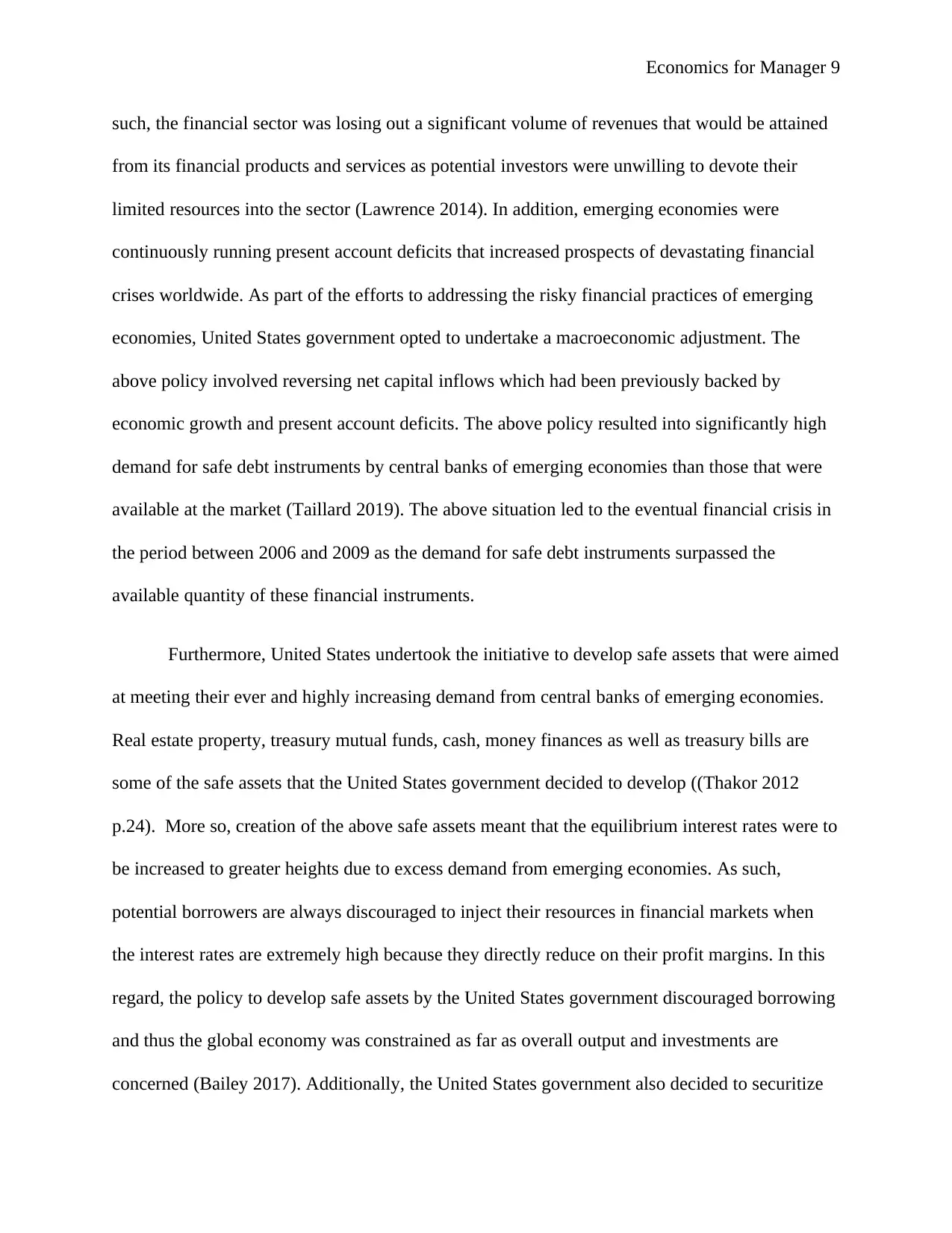
Economics for Manager 9
such, the financial sector was losing out a significant volume of revenues that would be attained
from its financial products and services as potential investors were unwilling to devote their
limited resources into the sector (Lawrence 2014). In addition, emerging economies were
continuously running present account deficits that increased prospects of devastating financial
crises worldwide. As part of the efforts to addressing the risky financial practices of emerging
economies, United States government opted to undertake a macroeconomic adjustment. The
above policy involved reversing net capital inflows which had been previously backed by
economic growth and present account deficits. The above policy resulted into significantly high
demand for safe debt instruments by central banks of emerging economies than those that were
available at the market (Taillard 2019). The above situation led to the eventual financial crisis in
the period between 2006 and 2009 as the demand for safe debt instruments surpassed the
available quantity of these financial instruments.
Furthermore, United States undertook the initiative to develop safe assets that were aimed
at meeting their ever and highly increasing demand from central banks of emerging economies.
Real estate property, treasury mutual funds, cash, money finances as well as treasury bills are
some of the safe assets that the United States government decided to develop ((Thakor 2012
p.24). More so, creation of the above safe assets meant that the equilibrium interest rates were to
be increased to greater heights due to excess demand from emerging economies. As such,
potential borrowers are always discouraged to inject their resources in financial markets when
the interest rates are extremely high because they directly reduce on their profit margins. In this
regard, the policy to develop safe assets by the United States government discouraged borrowing
and thus the global economy was constrained as far as overall output and investments are
concerned (Bailey 2017). Additionally, the United States government also decided to securitize
such, the financial sector was losing out a significant volume of revenues that would be attained
from its financial products and services as potential investors were unwilling to devote their
limited resources into the sector (Lawrence 2014). In addition, emerging economies were
continuously running present account deficits that increased prospects of devastating financial
crises worldwide. As part of the efforts to addressing the risky financial practices of emerging
economies, United States government opted to undertake a macroeconomic adjustment. The
above policy involved reversing net capital inflows which had been previously backed by
economic growth and present account deficits. The above policy resulted into significantly high
demand for safe debt instruments by central banks of emerging economies than those that were
available at the market (Taillard 2019). The above situation led to the eventual financial crisis in
the period between 2006 and 2009 as the demand for safe debt instruments surpassed the
available quantity of these financial instruments.
Furthermore, United States undertook the initiative to develop safe assets that were aimed
at meeting their ever and highly increasing demand from central banks of emerging economies.
Real estate property, treasury mutual funds, cash, money finances as well as treasury bills are
some of the safe assets that the United States government decided to develop ((Thakor 2012
p.24). More so, creation of the above safe assets meant that the equilibrium interest rates were to
be increased to greater heights due to excess demand from emerging economies. As such,
potential borrowers are always discouraged to inject their resources in financial markets when
the interest rates are extremely high because they directly reduce on their profit margins. In this
regard, the policy to develop safe assets by the United States government discouraged borrowing
and thus the global economy was constrained as far as overall output and investments are
concerned (Bailey 2017). Additionally, the United States government also decided to securitize
⊘ This is a preview!⊘
Do you want full access?
Subscribe today to unlock all pages.

Trusted by 1+ million students worldwide
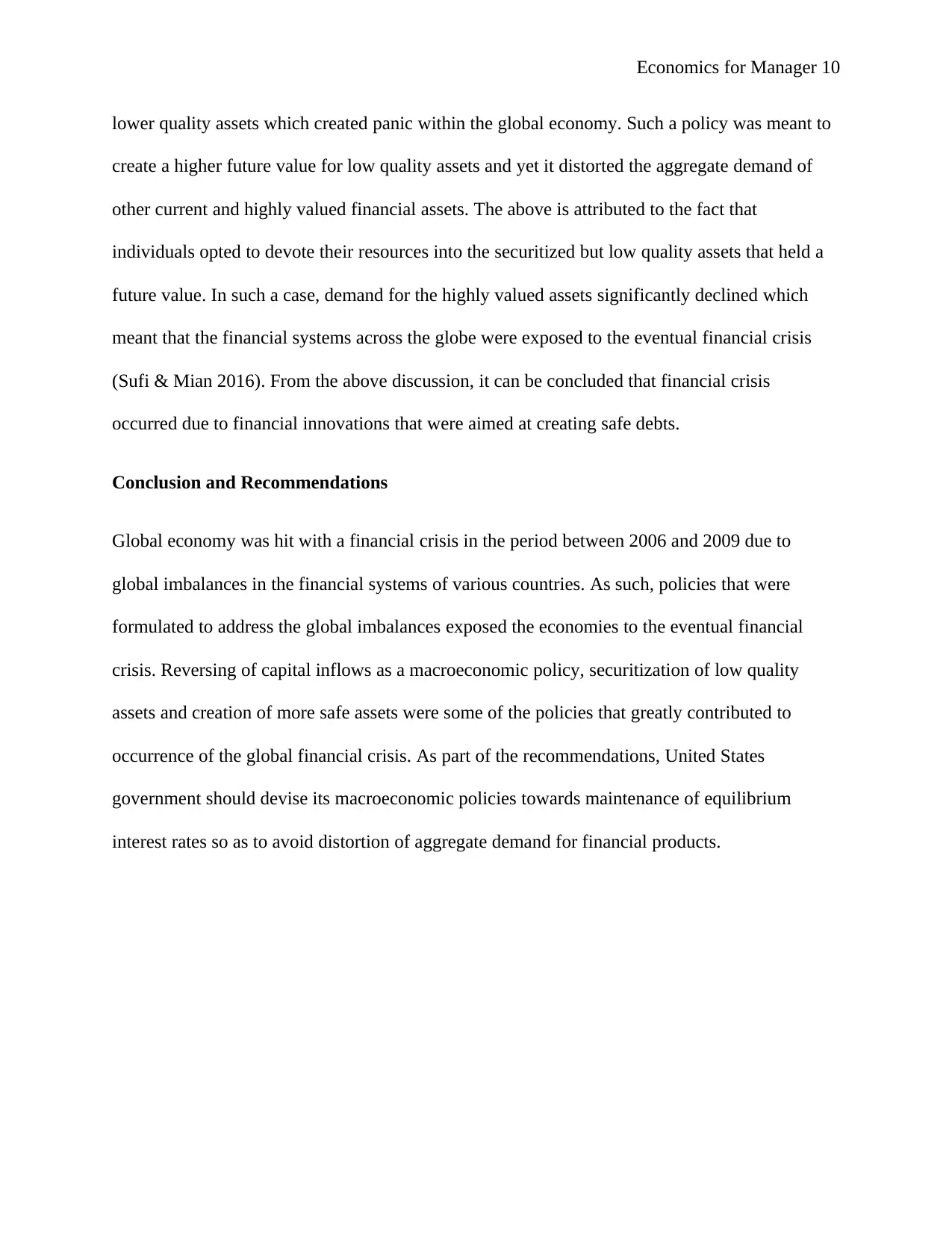
Economics for Manager 10
lower quality assets which created panic within the global economy. Such a policy was meant to
create a higher future value for low quality assets and yet it distorted the aggregate demand of
other current and highly valued financial assets. The above is attributed to the fact that
individuals opted to devote their resources into the securitized but low quality assets that held a
future value. In such a case, demand for the highly valued assets significantly declined which
meant that the financial systems across the globe were exposed to the eventual financial crisis
(Sufi & Mian 2016). From the above discussion, it can be concluded that financial crisis
occurred due to financial innovations that were aimed at creating safe debts.
Conclusion and Recommendations
Global economy was hit with a financial crisis in the period between 2006 and 2009 due to
global imbalances in the financial systems of various countries. As such, policies that were
formulated to address the global imbalances exposed the economies to the eventual financial
crisis. Reversing of capital inflows as a macroeconomic policy, securitization of low quality
assets and creation of more safe assets were some of the policies that greatly contributed to
occurrence of the global financial crisis. As part of the recommendations, United States
government should devise its macroeconomic policies towards maintenance of equilibrium
interest rates so as to avoid distortion of aggregate demand for financial products.
lower quality assets which created panic within the global economy. Such a policy was meant to
create a higher future value for low quality assets and yet it distorted the aggregate demand of
other current and highly valued financial assets. The above is attributed to the fact that
individuals opted to devote their resources into the securitized but low quality assets that held a
future value. In such a case, demand for the highly valued assets significantly declined which
meant that the financial systems across the globe were exposed to the eventual financial crisis
(Sufi & Mian 2016). From the above discussion, it can be concluded that financial crisis
occurred due to financial innovations that were aimed at creating safe debts.
Conclusion and Recommendations
Global economy was hit with a financial crisis in the period between 2006 and 2009 due to
global imbalances in the financial systems of various countries. As such, policies that were
formulated to address the global imbalances exposed the economies to the eventual financial
crisis. Reversing of capital inflows as a macroeconomic policy, securitization of low quality
assets and creation of more safe assets were some of the policies that greatly contributed to
occurrence of the global financial crisis. As part of the recommendations, United States
government should devise its macroeconomic policies towards maintenance of equilibrium
interest rates so as to avoid distortion of aggregate demand for financial products.
Paraphrase This Document
Need a fresh take? Get an instant paraphrase of this document with our AI Paraphraser
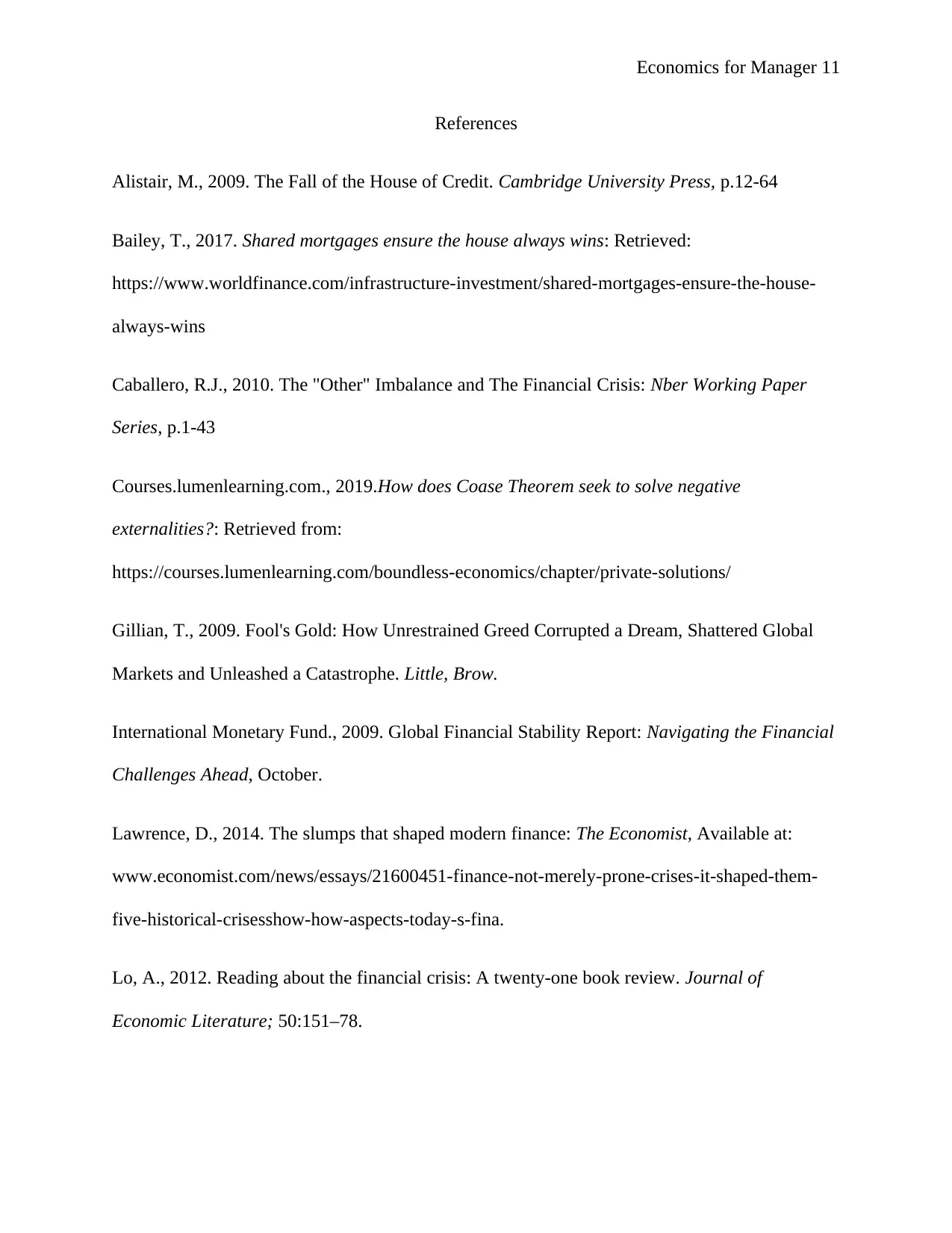
Economics for Manager 11
References
Alistair, M., 2009. The Fall of the House of Credit. Cambridge University Press, p.12-64
Bailey, T., 2017. Shared mortgages ensure the house always wins: Retrieved:
https://www.worldfinance.com/infrastructure-investment/shared-mortgages-ensure-the-house-
always-wins
Caballero, R.J., 2010. The "Other" Imbalance and The Financial Crisis: Nber Working Paper
Series, p.1-43
Courses.lumenlearning.com., 2019.How does Coase Theorem seek to solve negative
externalities?: Retrieved from:
https://courses.lumenlearning.com/boundless-economics/chapter/private-solutions/
Gillian, T., 2009. Fool's Gold: How Unrestrained Greed Corrupted a Dream, Shattered Global
Markets and Unleashed a Catastrophe. Little, Brow.
International Monetary Fund., 2009. Global Financial Stability Report: Navigating the Financial
Challenges Ahead, October.
Lawrence, D., 2014. The slumps that shaped modern finance: The Economist, Available at:
www.economist.com/news/essays/21600451-finance-not-merely-prone-crises-it-shaped-them-
five-historical-crisesshow-how-aspects-today-s-fina.
Lo, A., 2012. Reading about the financial crisis: A twenty-one book review. Journal of
Economic Literature; 50:151–78.
References
Alistair, M., 2009. The Fall of the House of Credit. Cambridge University Press, p.12-64
Bailey, T., 2017. Shared mortgages ensure the house always wins: Retrieved:
https://www.worldfinance.com/infrastructure-investment/shared-mortgages-ensure-the-house-
always-wins
Caballero, R.J., 2010. The "Other" Imbalance and The Financial Crisis: Nber Working Paper
Series, p.1-43
Courses.lumenlearning.com., 2019.How does Coase Theorem seek to solve negative
externalities?: Retrieved from:
https://courses.lumenlearning.com/boundless-economics/chapter/private-solutions/
Gillian, T., 2009. Fool's Gold: How Unrestrained Greed Corrupted a Dream, Shattered Global
Markets and Unleashed a Catastrophe. Little, Brow.
International Monetary Fund., 2009. Global Financial Stability Report: Navigating the Financial
Challenges Ahead, October.
Lawrence, D., 2014. The slumps that shaped modern finance: The Economist, Available at:
www.economist.com/news/essays/21600451-finance-not-merely-prone-crises-it-shaped-them-
five-historical-crisesshow-how-aspects-today-s-fina.
Lo, A., 2012. Reading about the financial crisis: A twenty-one book review. Journal of
Economic Literature; 50:151–78.
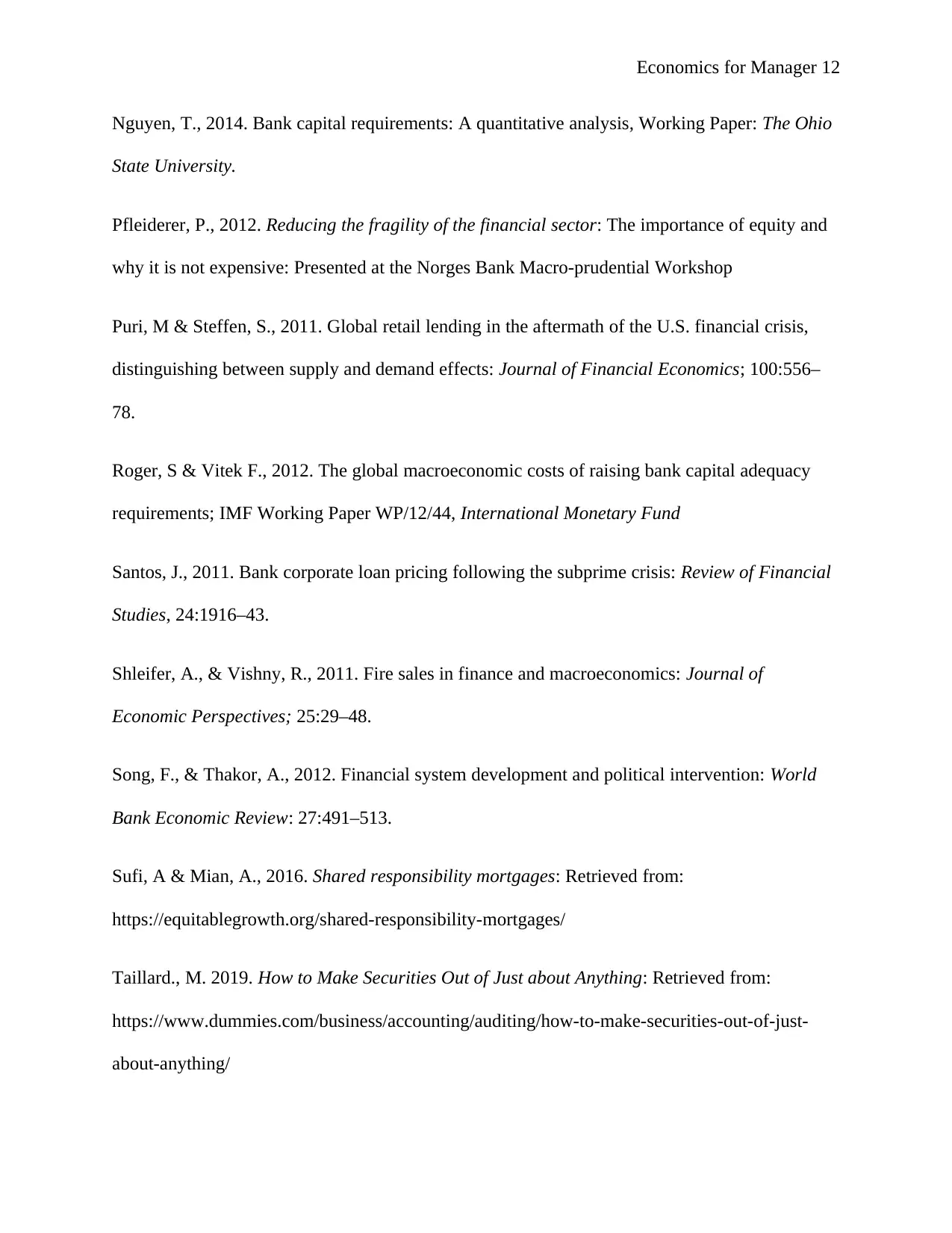
Economics for Manager 12
Nguyen, T., 2014. Bank capital requirements: A quantitative analysis, Working Paper: The Ohio
State University.
Pfleiderer, P., 2012. Reducing the fragility of the financial sector: The importance of equity and
why it is not expensive: Presented at the Norges Bank Macro-prudential Workshop
Puri, M & Steffen, S., 2011. Global retail lending in the aftermath of the U.S. financial crisis,
distinguishing between supply and demand effects: Journal of Financial Economics; 100:556–
78.
Roger, S & Vitek F., 2012. The global macroeconomic costs of raising bank capital adequacy
requirements; IMF Working Paper WP/12/44, International Monetary Fund
Santos, J., 2011. Bank corporate loan pricing following the subprime crisis: Review of Financial
Studies, 24:1916–43.
Shleifer, A., & Vishny, R., 2011. Fire sales in finance and macroeconomics: Journal of
Economic Perspectives; 25:29–48.
Song, F., & Thakor, A., 2012. Financial system development and political intervention: World
Bank Economic Review: 27:491–513.
Sufi, A & Mian, A., 2016. Shared responsibility mortgages: Retrieved from:
https://equitablegrowth.org/shared-responsibility-mortgages/
Taillard., M. 2019. How to Make Securities Out of Just about Anything: Retrieved from:
https://www.dummies.com/business/accounting/auditing/how-to-make-securities-out-of-just-
about-anything/
Nguyen, T., 2014. Bank capital requirements: A quantitative analysis, Working Paper: The Ohio
State University.
Pfleiderer, P., 2012. Reducing the fragility of the financial sector: The importance of equity and
why it is not expensive: Presented at the Norges Bank Macro-prudential Workshop
Puri, M & Steffen, S., 2011. Global retail lending in the aftermath of the U.S. financial crisis,
distinguishing between supply and demand effects: Journal of Financial Economics; 100:556–
78.
Roger, S & Vitek F., 2012. The global macroeconomic costs of raising bank capital adequacy
requirements; IMF Working Paper WP/12/44, International Monetary Fund
Santos, J., 2011. Bank corporate loan pricing following the subprime crisis: Review of Financial
Studies, 24:1916–43.
Shleifer, A., & Vishny, R., 2011. Fire sales in finance and macroeconomics: Journal of
Economic Perspectives; 25:29–48.
Song, F., & Thakor, A., 2012. Financial system development and political intervention: World
Bank Economic Review: 27:491–513.
Sufi, A & Mian, A., 2016. Shared responsibility mortgages: Retrieved from:
https://equitablegrowth.org/shared-responsibility-mortgages/
Taillard., M. 2019. How to Make Securities Out of Just about Anything: Retrieved from:
https://www.dummies.com/business/accounting/auditing/how-to-make-securities-out-of-just-
about-anything/
⊘ This is a preview!⊘
Do you want full access?
Subscribe today to unlock all pages.

Trusted by 1+ million students worldwide
1 out of 13
Related Documents
Your All-in-One AI-Powered Toolkit for Academic Success.
+13062052269
info@desklib.com
Available 24*7 on WhatsApp / Email
![[object Object]](/_next/static/media/star-bottom.7253800d.svg)
Unlock your academic potential
Copyright © 2020–2025 A2Z Services. All Rights Reserved. Developed and managed by ZUCOL.





